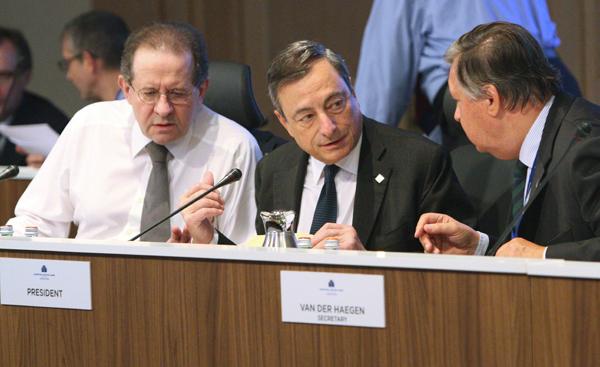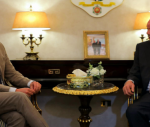You are here
ECB fires off volley of anti-deflation shots
By AFP - Jun 05,2014 - Last updated at Jun 05,2014
FRANKFURT — The European Central Bank (ECB) rolled out Thursday an unprecedented package of measures, including negative interest rates, in its fight to head off the spectre of deflation in the euro area.
ECB Chief Mario Draghi insisted that the 18 countries that share the euro are not actually on the brink of deflation, a potentially crippling downward spiral of falling prices.
But action was needed to kick-start ailing lending in the region, Draghi argued.
Thus, the ECB entered unchartered waters, taking one of its key interest rates into negative territory for the first time.
The ECB lowered all three of its key interest rates: the benchmark refi refinancing rate was cut to 0.15 per cent from 0.25 per cent, the interest rate on the marginal lending facility was trimmed to 0.40 per cent from 0.75 per cent.
And the deposit rate, the rate at which the central bank pays commercial banks for depositing their unused cash, was reduced from zero per cent to minus 0.10 per cent.
This means that banks will be charged for parking funds at the ECB in the hope they might lend it on to businesses and consumers instead.
Rates can’t go lower
Draghi admitted that interest rates cannot go down any further.
“For all the practical purposes we have reached the lower bound,” he said.
But on top of the rate cuts, Draghi unveiled a series of measures to spur bank credit, which has been contracting for months now.
And “if required, we will act swiftly with further monetary policy easing”, Draghi pledged.
The ECB already pumped vast amounts of liquidity into the banking system at the end of 2011 and the beginning of 2012 using so-called Long-Term Refinancing Operations.
But at that time, banks did not lend the cash on to the small and medium-sized companies that form the backbone of the eurozone economy.
So this time, the ECB is targeting the loans so as to encourage banks to lend to households and non-financial corporations.
Draghi said the ECB was also working on US Federal Reserve-style bond-buying by purchasing asset-backed securities from banks.
And the ECB has decided to stop “sterilising” the liquidity injected from its Securities Markets Programme, under which the ECB purchased bonds from troubled “peripheral” eurozone countries, he said.
All in all, the combination of measures would “provide further monetary policy accommodation and support lending to the real economy,” Draghi said.
ECB action ‘strongly welcome’
In Washington, the International Monetary Fund “strongly welcomed” the ECB’s “very pro-active stance”.
Analysts were similarly cheered, but cautioned that the initial euphoria might evaporate.
“Taken together, today’s package of policy measures is a strong one, underlining the ECB’s determination and willingness to act,” said ING DiBa economist Carsten Brzeski.
“However, as so often during the euro crisis, first-glance-enthusiasm doesn’t always last,” he warned. “The ECB has no guarantee that the economy and lending to the private sector can really be kick-started. The ECB is still dependent on banks. To some extent, the wish is still father to the thought,”
Markit economist Chris Williamson was more hopeful.
“It will take some time to gauge the longer term effectiveness of the measures,” he said. “The effectiveness of a negative deposit rate is uncertain and the [new liquidity measures] may also have only a limited impact on actual lending.”
But more importantly, “it is probably the lift to business and consumer confidence that will result from the decisiveness of the policy action that will do the most to help the economic recovery find its legs”, Williamson added.
Tom Rogers at EY Eurozone Forecast was “moderately encouraged” by the ECB action.
“But we remain concerned that the ECB is continuing to understate the risk of a prolonged period of low inflation or falling prices,” he warned.
Related Articles
FRANKFURT — European Central Bank (ECB) chief Mario Draghi unleashed a bold easing package on Thursday, cutting rates and expanding asset bu
FRANKFURT AM MAIN — The European Central Bank (ECB) is widely expected on Thursday to lower negative interest rates even further, and possib
VALLETTA/FRANKFURT — The European Central Bank (ECB) is studying new stimulus measures that could be unveiled as soon as December and is pre



















